If you are looking to enhance your garden with not just beautiful flowers, but also magnificent foliage, one of your best options is to try planting some coral bells.
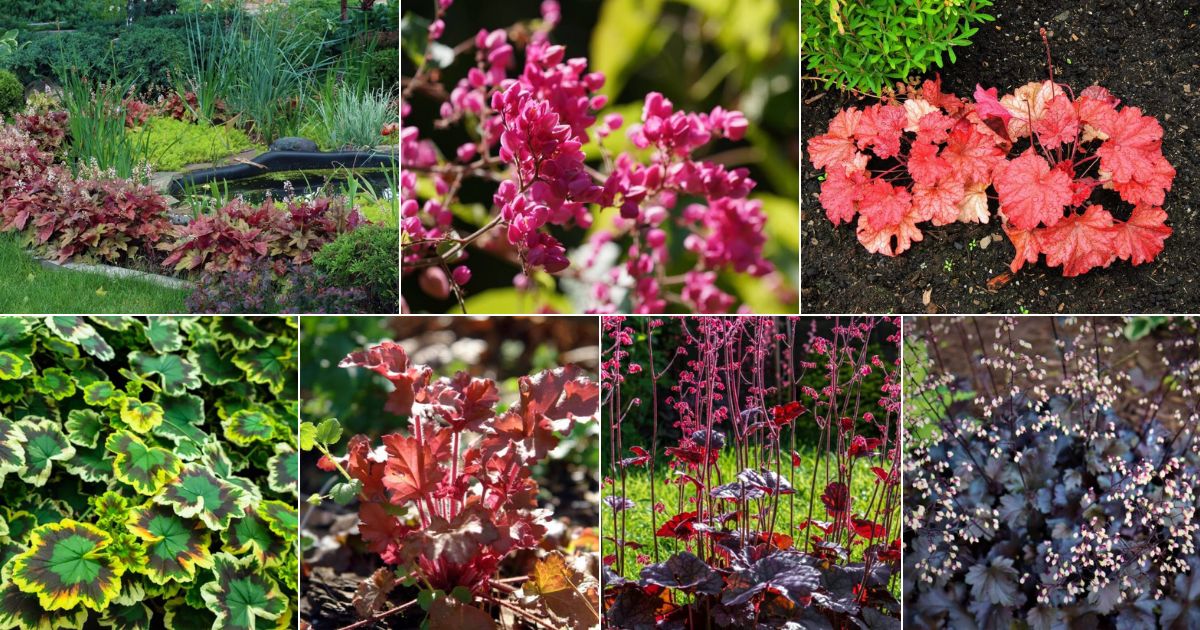
These perennials are among the most frequently recommended ones for companion planting because their stunning leaves can make a great accompaniment to other plants, or fill out spaces left behind by plants that have wilted for the season.
This guide will teach you all about the different types of coral bells. You will also learn how to plant them and take care of them. We will give you some companion planting ideas as well, and go over what you need to know about diseases and pests.
Jump to:
- What Are Coral Bells?
- Coral Bells Basics
- Where Do Coral Bells Grow?
- Why Grow Coral Bells?
- Recommended Coral Bells Varieties
- When Do Coral Bells Bloom?
- How Long Do Coral Bells Bloom?
- How Big Do Coral Bells Get?
- When to Plant Coral Bells
- Ideal Growing Conditions for Coral Bells
- How to Plant Coral Bells
- How to Care for Coral Bells
- Recommended Companion Plants for Coral Bells
- Frequently Asked Questions About Growing Coral Bells
- Where to Buy Coral Bells
What Are Coral Bells?
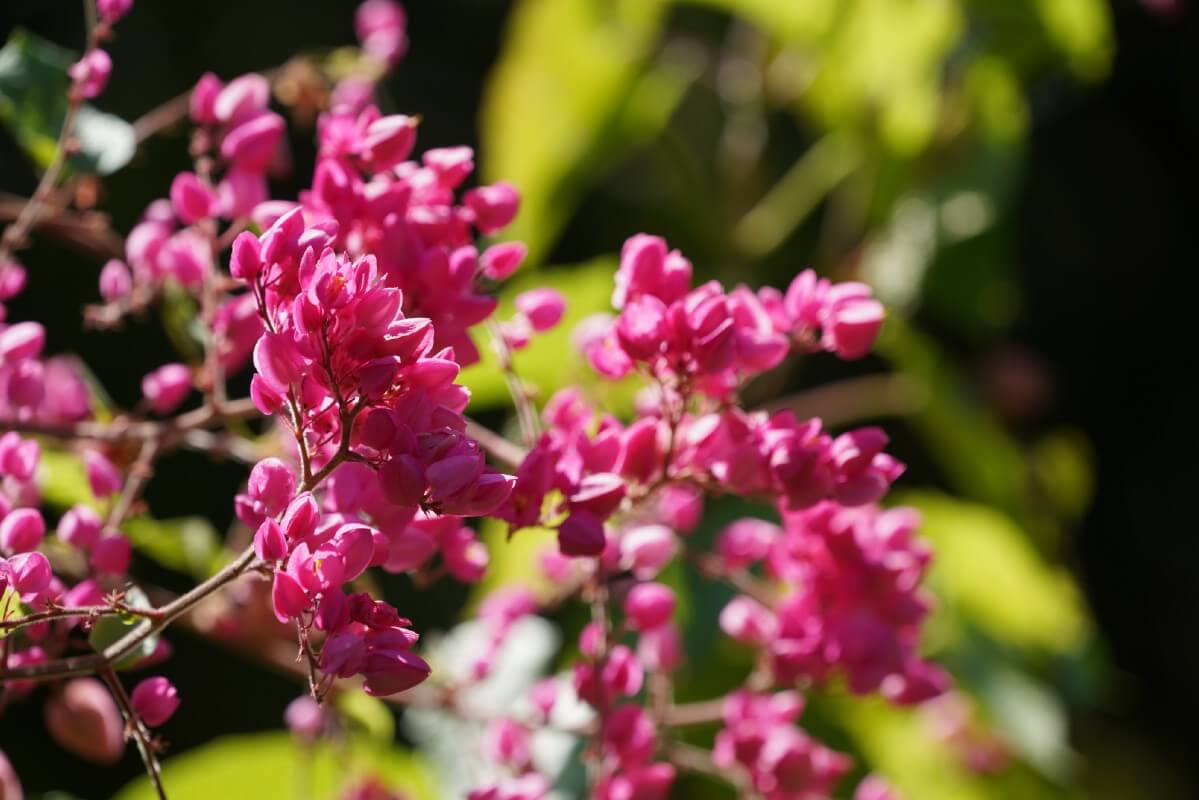
The common name coral bells refers to the Heuchera genus of plants. Sometimes, they are also called “alumroot.” Many people also just refer to them as “heucheras.”
There are around 37 different species of coral bells along with numerous cultivars.
You will be stunned by the diversity of these varieties. Many of them look nothing alike.
The majority of coral bells are evergreen plants, so their foliage remains beautiful throughout the winter months.
Coral Bells Basics
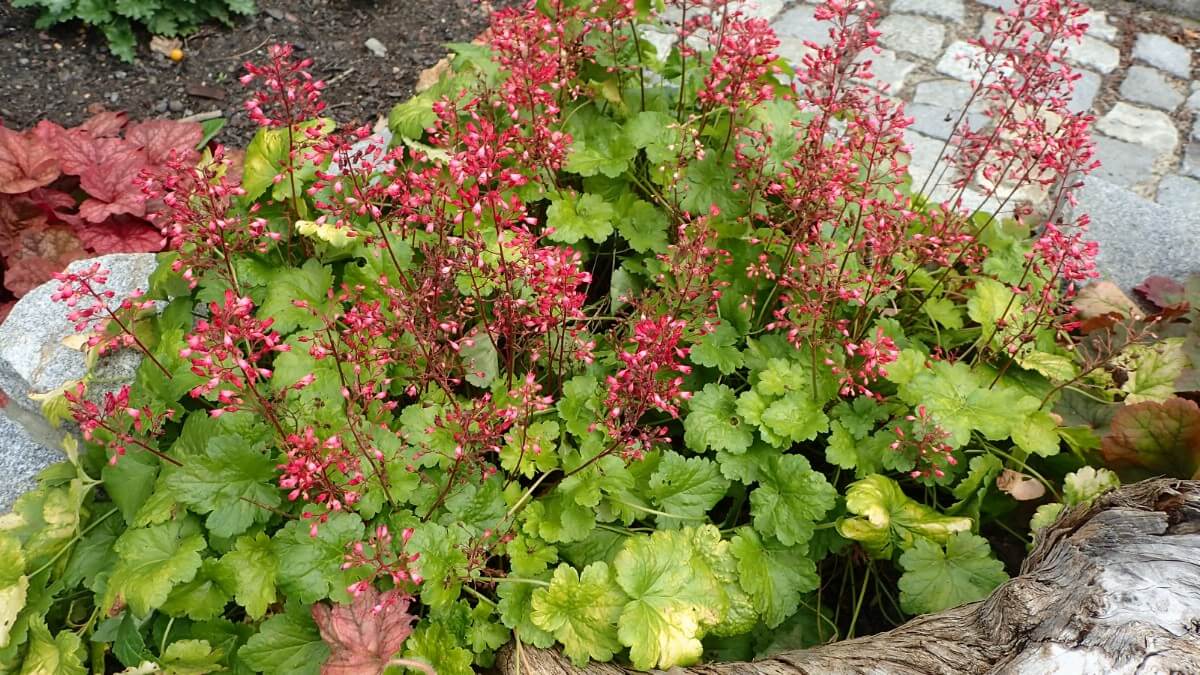
| Zones: | 4-9 (varies) |
| Sun: | Full-partial |
| Water: | 1 inch per week, extra in full sun |
| Soil: | Moist, rich, well-drained |
| Blooming season: | Spring through summer |
| Expected height: | 6-16 inches |
Where Do Coral Bells Grow?
Coral bells are native to North America, but now are grown in other locations throughout the world. They are tolerant of diverse conditions, which is one of the reasons why various species appear so distinct from each other. They have simply adapted to different environments.
Why Grow Coral Bells?
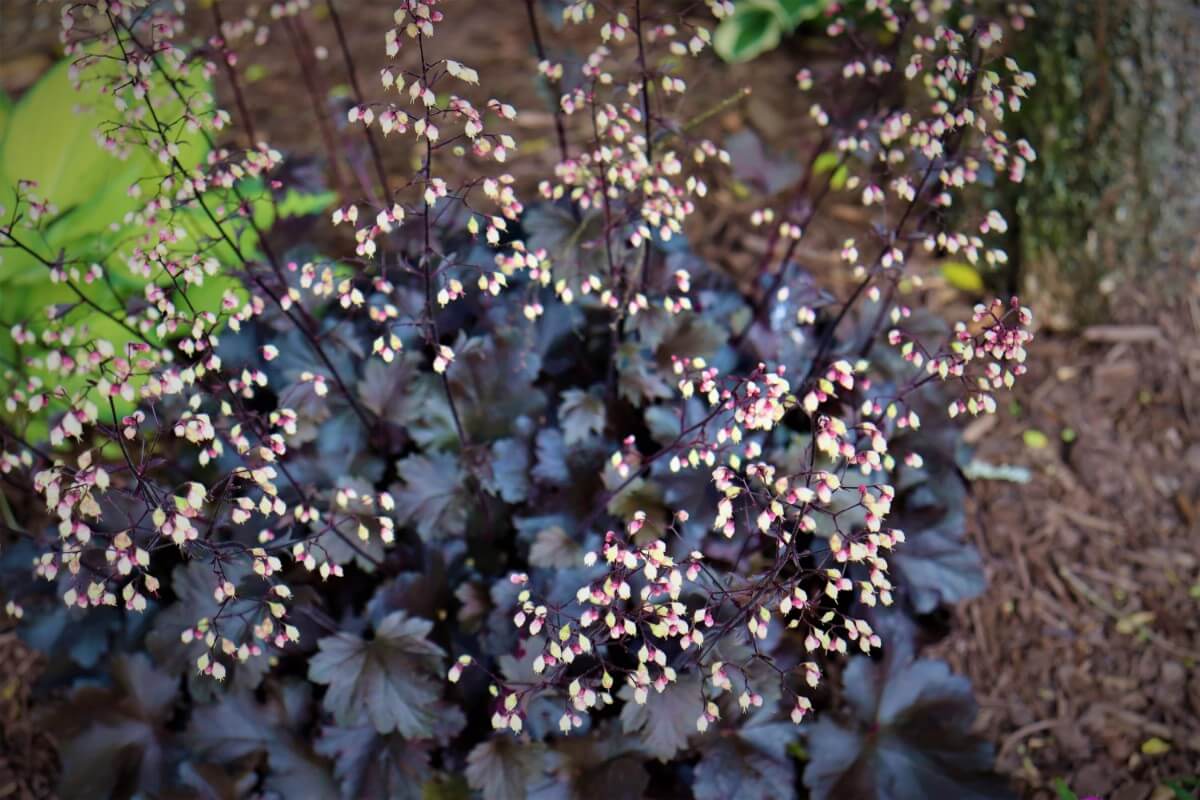
Coral bells are some of the most versatile plants around, so there are many great reasons to grow them. Here are some of their benefits in your garden:
Grow coral bells in sun or shade. No matter what conditions you have to work with in your garden, you should be able to find a suitable spot for heucheras to grow.
These plants can tolerate a range of soil conditions. This adds to their versatility, again making them suitable for many different types of gardens.
Coral bells are drought-resistant. Once established, coral bells are pretty good at surviving dry conditions. Of course, you still need to water them to keep them healthy, but they should be able to endure better than many other plants that are more sensitive to moisture loss.
Coral bells produce stunning, colorful leaves. Many of these leaf colors are quite unusual, and will attract the eye just as much as colorful flowers. The leaves can have appealing shapes as well, and the shapes, like the colors, can vary from one cultivar to another.
While coral bell flowers are tiny, they are still pretty. With coral bells, the showy leaves are the main attraction, with the flowers taking a backseat. But that does not mean that each delicate flower does not add its own touch of beauty. And when the flower color contrasts with the leaves, it can mean an even more spectacular show.
Butterflies and bees like coral bells. Want to see more pollinators in your garden? Planting heucheras may be one way to entice them.
Coral bells are low-maintenance plants. After they are established, you will find that they do well weathering a range of conditions without a whole lot of work on your part.
Slugs and snails will not eat them. If snails and slugs cause a lot of problems in your garden, you will be relieved to hear that coral bells are one type of plant that they should steer well clear of.
These perennials make outstanding companion plants. With so many different hues of spectacular foliage to choose from, you can find just the right color to offset any other plants you want to show off.
You will never tire of the dazzling variety of coral bell cultivars. You will be astonished by just how different one type can look from the next.
Coral bells add year-round interest to your garden. When other plants die back for the winter, heucheras may continue to flourish, giving your garden a full, colorful appearance.
Recommended Coral Bells Varieties
Let’s check out some of the beautiful cultivars of coral bells that you can plant to spruce up your garden!
Citronelle Heuchera: One cool cultivar of coral bells to consider planting is “Citronelle Heuchera,” named for the yellowish color of its leaves. If you look at photos, you will notice that how green or yellow each plant appears can vary. But this is actually something that you have a degree of control over. By planting this cultivar in more shade, you will get a hue that is closer to chartreuse. By planting it in more sun, you will get yellow or leaves. It produces creamy blossoms.

Dolce Blackberry Ice Heuchera: Do you want a plant with black leaves that will make every other plant around it stand out? Consider the “Dolce Blackberry Ice” variety of coral bells. The leaves are actually a deep purple color (like blackberries), and the flowers are a contrasting yellow.
Obsidian Heuchera: Another option if you desire black among your foliage colors is “Obsidian Heuchera.” You will find few other plants with leaves this dark. This type of coral bells plant also features white flowers. They stand out nicely against the dark leaves. If you look closely, you will discover that the actual color of the leaves is reddish-purplish.
Primo Wild Rose: Another type of heuchera that will contrast beautifully with the green leaves around it is this cultivar, named for the rosy colors of both its leaves and flowers. In fact, its foliage colors are so rich that they could easily be mistaken for a clump of flowers from a distance.
Ginger Ale Heuchera: The name of this cultivar refers to the color of its leaves, which are gingery. It produces yellow and pink flowers. As the leaves are so light in color, they look stunning next to a cultivar that features dark leaves such as Obsidian or Blackberry Ice.
Dolce Wildberry Heuchera: Want to plant coral bells with purple leaves? This variety of heuchera features foliage with a spectacularly vivid purple hue.
Shanghai Heuchera: This is another option if you want purplish leaves. The white flowers and dark stems also contribute to the splendour of this variety of coral bells.
Stainless Steel Heuchera: The “Stainless Steel” cultivar of coral bells features leaves with a silvery, almost metallic look. There are purplish veins running through the leaves, and their undersides are eggplant color. They produce pink buds that blossom into white flowers. This variety is particularly fond of shady woodland settings.
Primo Peachberry Ice Heuchera: Not surprisingly given its name, this plant features peach-colored leaves. Nevertheless, it is one thing to read about it and another to see it. You will be astonished by the bright colors of the leaves. This cultivar produces flowers with a creamy hue.
Primo Black Pearl Heuchera: Dark purple leaves with ruffled edges define this exquisite cultivar. The flowers bud pink and then blossom white.
Dolce Cherry Truffles Heuchera: Here’s a confection you can’t say “no to”—a beautiful and distinctive cultivar of coral bells that features pink flowers and deep reddish leaves.
Lime Ruffles Heuchera: The name of this cultivar is an apt description of its leaves, which are a bright lime green color with ruffled edges. It produces white flowers. One of the reasons this variety of coral bells is popular is because it can tolerate heat better than most. So, it might do well in a warmer climate or sunny or location than some of the other varieties on this list.
Glitter Heuchera: To bring another spectacular look to your garden, consider this variety, featuring leaves with dark veins and a silvery sheen. The pink blossoms are showier than most, adding to the beauty of this resplendent cultivar.
Amber Waves Heuchera: Bring waves of amber to your garden with this well-named cultivar featuring leaves that look like warm autumn foliage. It produces pink flowers.
Midnight Rose Heuchera: Another cultivar you may enjoy is “Midnight Rose.” This one features creamy white flowers and dark, reddish leaves. But what makes the leaves really distinctive is the spatter of bright pink across them.
That is just a sampling of the wide variety of coral bells you can plant. With the variety of colors out there, you will have no problem finding the stunning foliage plants your garden needs.
When Do Coral Bells Bloom?
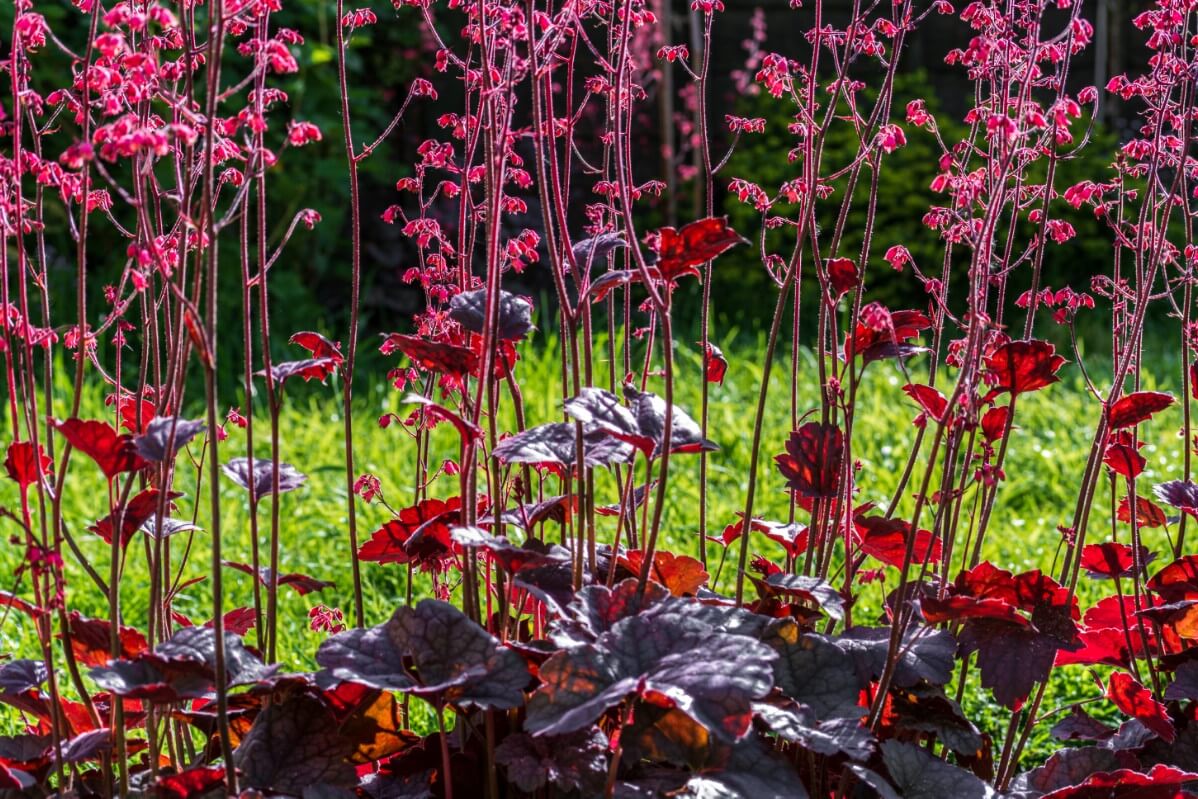
There are variations in the exact bloom time for coral bells since there are many species and cultivars. But generally speaking, you can expect them to blossom during late spring or early to midsummer.
How Long Do Coral Bells Bloom?
Each time your coral bells blossom, the flowers can last for up to three weeks.
So, you should get to enjoy the blooms for awhile, particularly if you cut back the stalks after they will to encourage a second bloom cycle (see the section on deadheading).
How Big Do Coral Bells Get?
You are probably wondering just how tall and wide you can expect these leafy plants to grow. Usually, the leaves themselves will max out at between 6 to 16 inches in height, and grow to span 12 to 36 inches in width. When the flower spikes grow, they will add some additional height. They can be up to three feet tall.
When to Plant Coral Bells
With coral bells, you have two options for planting times. You can either plant them early during the spring or late in autumn.
Ideal Growing Conditions for Coral Bells
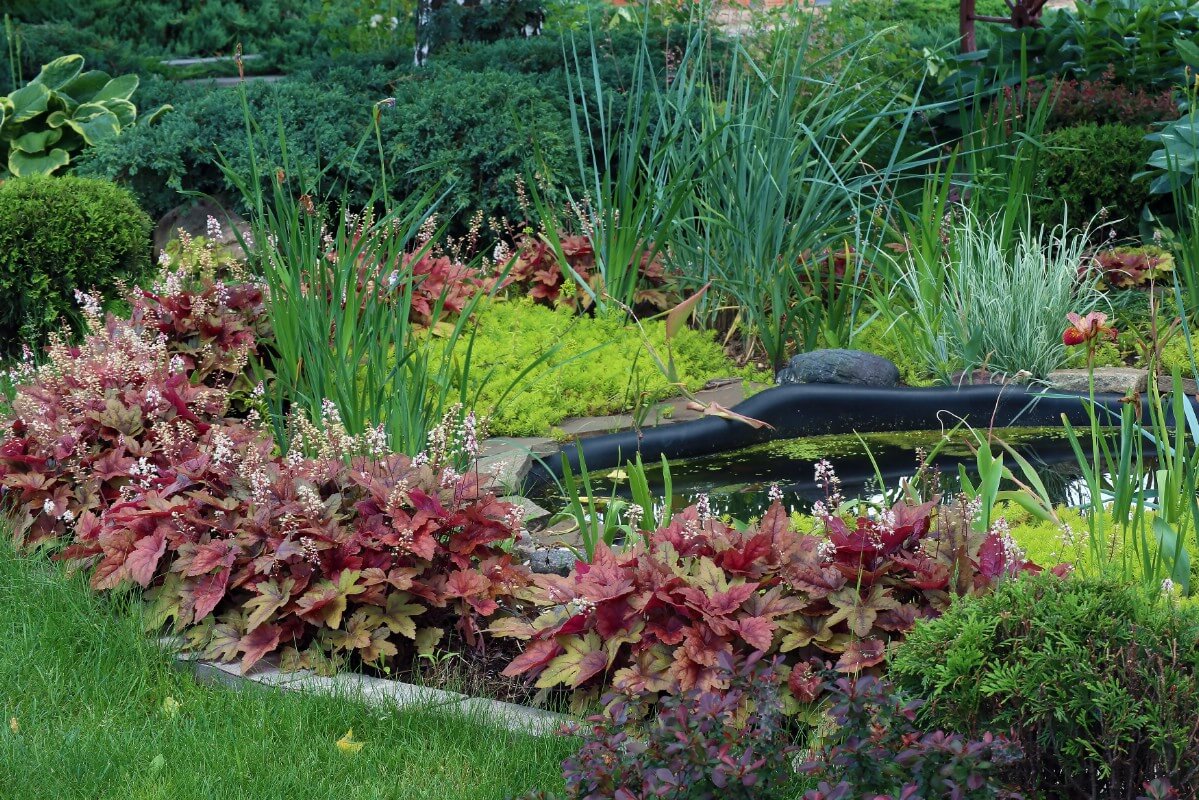
Now you know when to plant coral bells. But what are the ideal growing conditions for these beautiful, dramatic leafy plants?
How Much Sun Do Coral Bells Need?
You can grow coral bells in full or partial sunlight. Under most circumstances, partial shade is preferable. The ideal amount of direct sunlight each day is about four to six hours.
But if necessary, you can usually get coral bells to grow in full sun, though this typically will work out best if you live in a poor part of the world. Excessive heat is not good for these plants.
What Type of Soil is Right for Coral Bells?
Rich, well-draining soils are best for coral bells. Moist soil is good, but not soggy soil. Both neutral and mildly acidic soils are acceptable. Sandy soils, clay soils, and even rocky soils can all be okay. The plant adapts well to a variety of conditions.
How Much Water Do Coral Bells Need?
Your heucheras are most likely to thrive if you are giving them enough water to keep the soil moist. In some cases, the rain might take care of this for you.
That being said, if you underwater them on mistake, they probably will be forgiving under most circumstances.
One scenario where you might want to consider watering your coral bells a bit more than average is if you have them planted in full sunlight in a hot climate. These conditions can dry them out a bit too much.
How to Plant Coral Bells
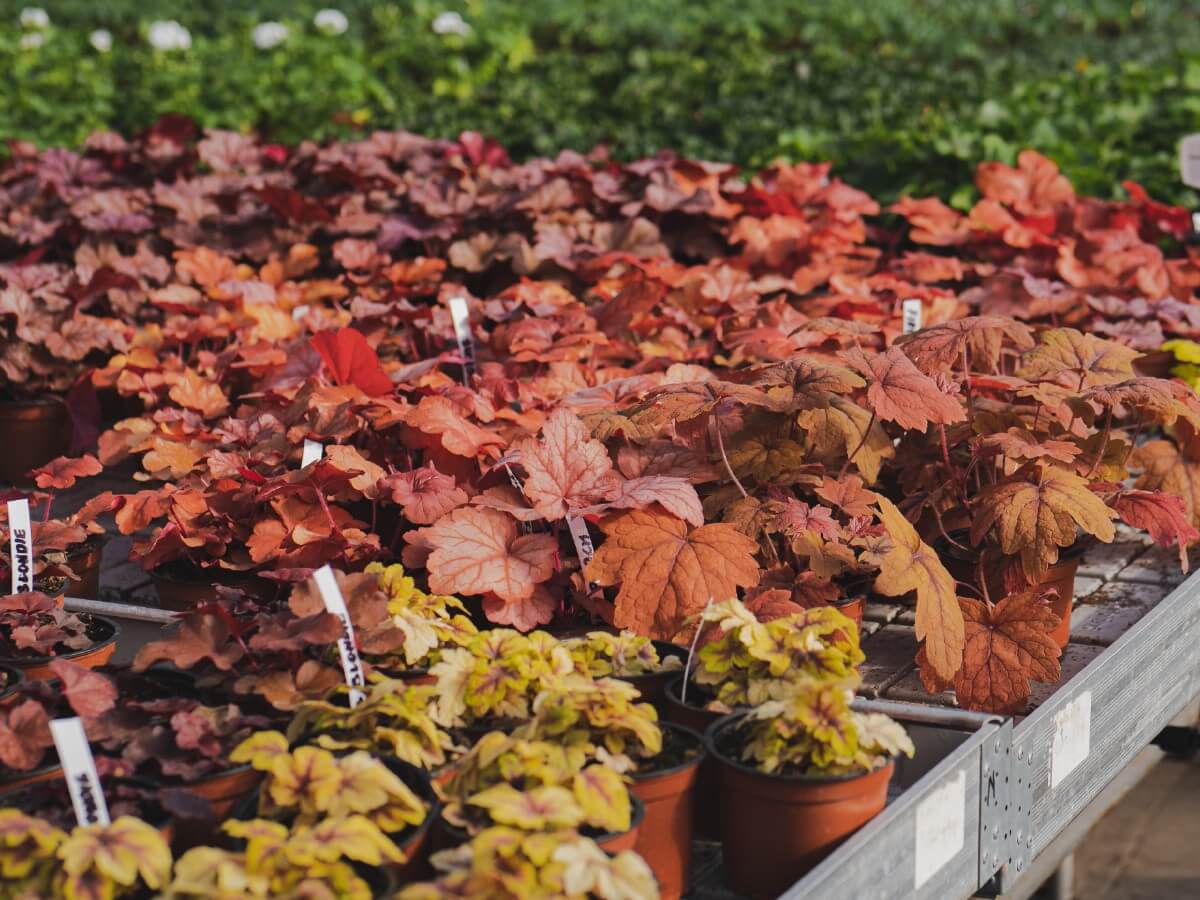
Now that we have discussed ideal growing conditions, we can talk about how to plant coral bells.
You can grow coral bells directly in your garden beds or in containers, so we will discuss both.
If you visit a garden center to purchase coral bells, you will probably find them already started in small containers. That means that you will essentially just be transplanting them when you get home.
Container Planting
Container-grown heucheras can look lovely on your patio or anywhere else in your yard. Here are the steps for growing coral bell plants in containers:
1. Pick out a container.
You will need to transfer your coral bells to larger, more appropriate long-term containers when you bring them home.
A suitable pot for coral bells in container gardens is one that is wide, but not necessarily tall. This plant does not grow deep roots, but they can spread out to the sides. One or more drainage holes is necessary.
2. Fill the container.
You can use all-purpose potting soil to grow these beautiful plants in containers.
3. Put the plant in the pot.
Next, make a hole in the soil. Carefully remove the plant from the container it came in. Shake out any loose soil caught in the roots, and then place it gently into the new container. Fill in the soil around it.
4. Add compost, then water your plant.
Half an inch of compost will help your plant to get off to the right start. This should go on top of the soil.
After you have finished adding the compost, water your plant.
5. Find a spot for your coral bell container plant.
Now, you just need to find the right place for your container. Partial shade will generally be ideal.
You might be wondering if it is possible to grow coral bells indoors. While these are usually outdoor plants, some people do grow them inside their homes as well.
Put them near a window where they can get some sunlight each day, but try to keep them from overheating.
In fact, you should be aware that conditions in your home will probably be too warm to get the full expected coloration.
Additionally, these plants usually need to go dormant for part of each year and that may not be possible indoors.
That could take a toll on your houseplant’s health.
For that reason, we do recommend that you try and keep them outdoors as much as possible.
If you initially keep one indoors and want to move it outdoors later, it will need to be hardened for about a week and a half.
6. Take care of your coral bells.
Water your coral bells to keep the soil moist. Remember to take extra care with your plants directly after transplanting them.
It is worth taking a moment to mention that if you are thinking about putting your coral bells on your patio or deck, you should consider whether they might be prone to overheating.
The surface of your deck or patio could reflect extra sunlight. If your plants are not in the shade or do not have a lot of shade, they could probably use more water then average.
Ground Planting
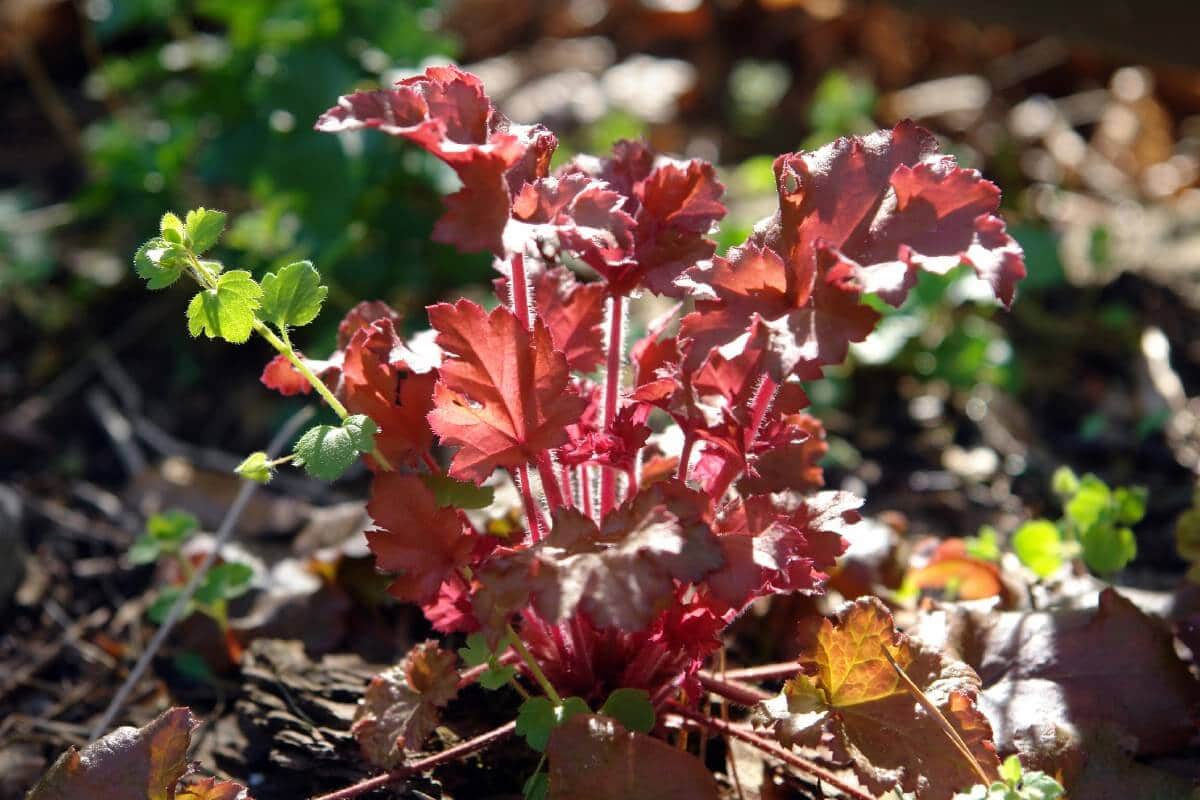
The basic steps for planting coral bells in the ground are much the same as they are for planting them in containers.
1. Choose a location.
For ground planting, it all starts with choosing a suitable location for your heuchera.
If partial shade is available, that is ideal.
You might also want to think about landscaping considerations. While that is always important with anything you plant, coral bells are great for filling in gaps in your garden, and can also offer intriguing contrasts for companion plants.
2. Plant your coral bells.
Dig suitable holes and plant your coral bells. Each one should be spaced about one to two feet apart from its companions.
3. Add compost.
Add about half an inch of compost.
4. Water deeply.
Once your coral bells are planted, water them.
5. Water consistently while your plant is establishing.
While your heucheras are establishing in your garden beds, be sure that you are keeping the soil moist.
Can You Grow Coral Bells from Seeds?
You might be wondering whether it is possible to plant coral bell seeds and grow them into beautiful, healthy plants.
The answer to this question is that it is possible to grow coral bells from seeds, but there is a caveat.
If you are trying to grow a hybrid variety, growing it from the seed is going to produce a plant that looks different from the one you got the seed from. If you want it to have the same appearance, you will need to divide the plant instead.
Planting a division will get you the look you are going for.
If you do decide to try growing coral bells from seed, here is what you need to do:
Get started either in early spring or in late autumn.
Place the seeds directly on top of the soil. Do not cover them!
If you are concerned about just leaving the seeds lying around on top of the soil in your garden beds, it might be a better idea to start them in your home in a container.
Either way, just make sure that they are getting plenty of direct light.
Assuming all goes well, within two to eight weeks or so, they should germinate.
If you planted the seeds directly in your garden bed, tend to them with care while they are establishing.
If, on the other hand, you started them indoors, do not forget to harden them before you bring them outside permanently.
During their first year of life, coral bells do require a bit more water than usual. After that, you can reduce the watering schedule.
Can You Grow Coral Bells from Cuttings?

Is it possible to propagate coral bells from cuttings? Yes! Here are the basic steps.
1. Take your cutting.
Begin by getting your cutting. It should consist of a stem that features an intact portion of root crown. Ideally, it should also have several leaves.
2. Dip the cutting into rooting hormone.
3. Insert the cutting into your rooting medium.
A variety of mediums can work, but sand is particularly suitable.
4. Wait for the cutting to root and grow.
It will take around 4-6 weeks for the cutting to root adequately.
5. Transplant the cutting.
Now you have a heuchera that you can transplant. Move it into a suitable container.
The container could serve as the new plant’s long-term home, or you could later move it to your garden bed.
If you kept it indoors at any point in the process, harden it before moving it outside.
You might be asking if it makes more sense to divide coral bells or take cuttings.
Between the two, the faster technique is to divide your plants. Dividing coral bells also is easier.
But with dividing, you can only get so many plants. You can get more with cuttings.
You do not necessarily have to just choose one method or the other, either. You can always do both.
How to Care for Coral Bells
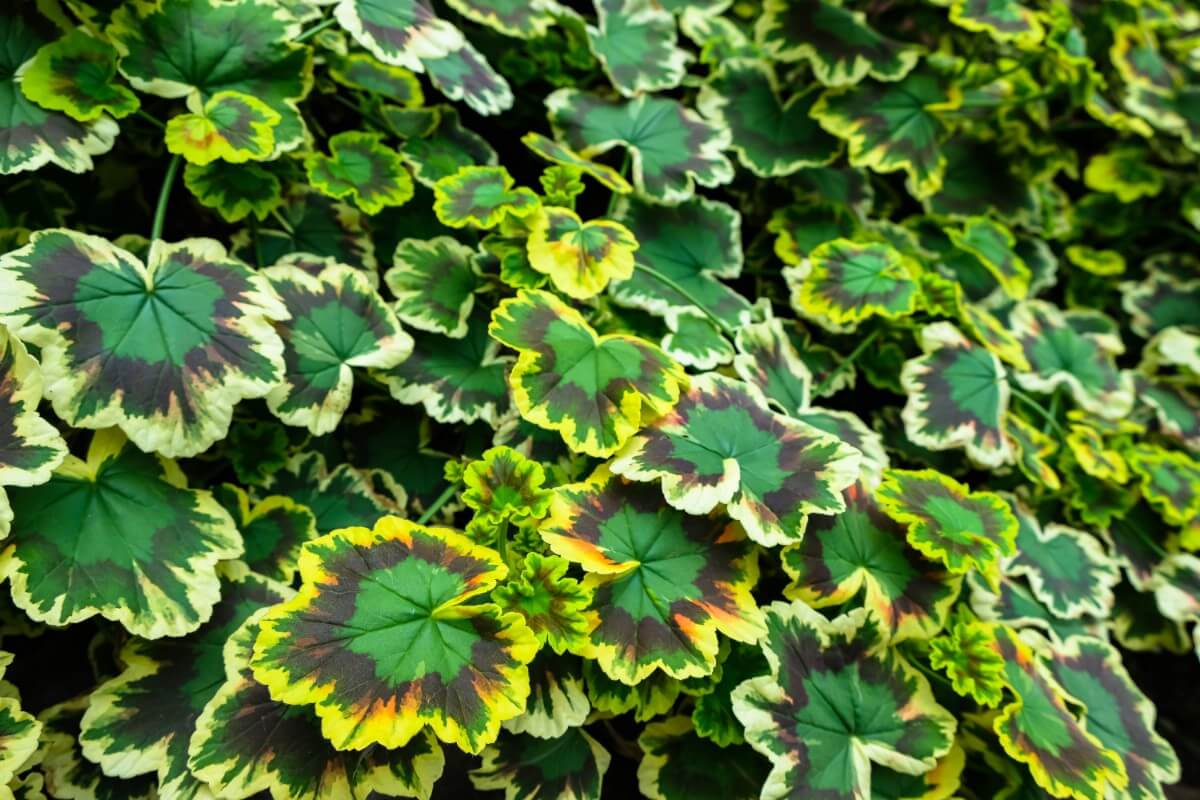
Having talked about growing heucheras from seeds, cuttings, or plants you have purchased from the store that were already started for you, let’s discuss how to take care of them.
How to Fertilize Coral Bells
Coral bells do appreciate compost or slow-release fertilizer. The best time to add these to the soil is in the spring. If you go with compost, about half an inch should do it.
Why should you not go with a quick-release fertilizer? The problem with this type of fertilizer is that it can reduce the amount of blossoms.
Also, make sure that you do not add too much fertilizer, as this can lead to the same problem.
Are you growing your coral bells in containers? If so, try using a fertilizer that is water-soluble.
How to Mulch Coral Bells
If you are in a location where it is hard to keep the soil moist because of an especially hot climate or drought conditions, it might be useful too protect your coral bells with a bit of mulch. Doing so will help these soil to retain moisture.
How to Stake Coral Bells
It is not necessary to stake coral bells. These are leafy plants that produce extremely small, lightweight flowers. Even though the flower stalks can reach several feet in height, the flowers will not weigh them down.
How to Prune Coral Bells
Coral bells are relatively low maintenance plans, but they can benefit from some limited pruning each year. This consists of deadheading as well as trimming away dead foliage.
How to Deadhead Coral Bells
If you want your coral bells to bloom twice in a season, it is actually possible. But you do not want to individually deadhead the spent blossoms. They are small and numerous, and this would take a long time.
But what you can do after the blossoms wilt is to simply cut back each stalk.
Just be aware that the second bloom probably will not be as dramatic as the first.
When to Cut Back Coral Bells
Coral bells are evergreen, so you do not need to trim them all the way back each year, nor would you want to.
Nevertheless, towards the end of winter or early in springtime, go check out your plants and see if there is any dead foliage.
If you find any, trim it away in preparation for the next year.
How to Divide Coral Bells

The roots of heucheras form clumps that increase in size over time.
Every couple of years during autumn, you can dig up your coral bells, and divide them.
1. Dig your plants up.
You can use a spade to cut a circle around each of your heuchera plants. Make sure that you are digging no closer than 6 inches out. Any nearer than that and you risk damaging the roots.
As you go, try and gently loosen the plant. Eventually, you should be able to get under it and push it up and out.
Important: You need to use the spade to push the plant out. Do not try and pull it out from above. You will probably injure it if you do that.
2. Remove dead foliage (this is a good time to take cuttings).
If there is any dead foliage, you should cut it away carefully with shears. If you want to take cuttings to propagate as well, you can do so at this stage.
3. Use a knife to divide the root clumps.
A serrated knife can help you to split apart the root clumps. The minimum width for a chunk of coral bells is 4 inches.
4. Re-plant the smaller clumps.
Now you have a number of smaller plants. Dig holes for them to plant them back in the ground.
5. Water your coral bells.
After you have finished transplanting your divided coral bells, water them thoroughly.
Remember that they will need a chance to establish, so continue to make sure that they are getting adequate moisture. But as it will be autumn, they should not be overheating.
Are Coral Bells Vulnerable to Diseases or Pests?
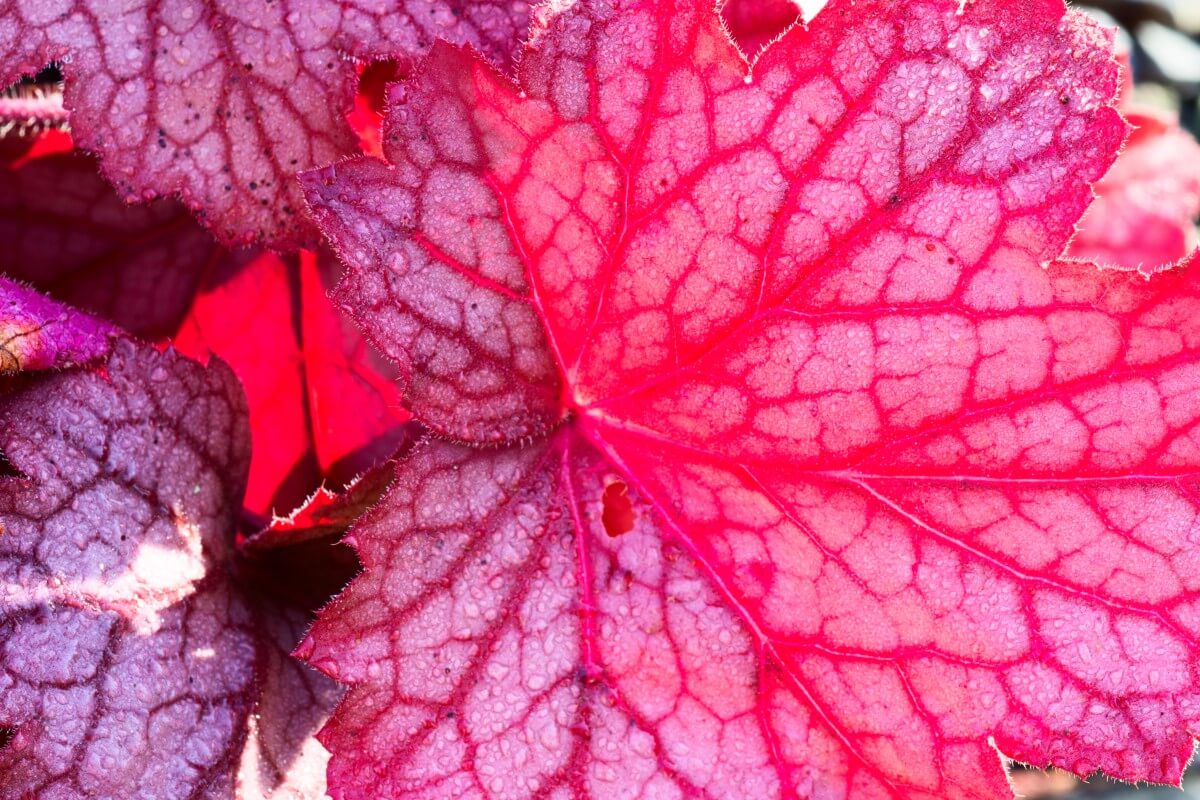
Although coral bells are hardy plants, there are some diseases that can affect them. The Connecticut Agricultural Experiment Station lists the following:
Downy mildew, Plasmopora spp.
Gray mold, flower and leaf blight, Botrytis cinerea.
Leaf spots, Cercospora, Colletotrichum, Phyllosticta or Septoria spp.
Powdery mildew, Erysiphe or Sphaerotheca spp.
Rust, Coleosporium or Puccinia spp.
Wilts, Verticillium spp.
There are also some insects that may end up harassing your heucheras.
Some examples include black vine weevils, mealybugs, and foliar nematodes.
Of all of these, it is the black vine weevils that are the most notorious.
The Connecticut Agricultural Experiment Station writes, “The larvae of this weevil often injure ornamental plants by feeding on the roots. The grubs devour the small roots and tunnel inside the crown of coral bells, weakening the plants. Leaf notching by adults can also be unsightly.”
If you try applying insecticide only to discover that the weevils are back a few days later, this is a common experience.
The Connecticut Agricultural Experiment Station says, “Insecticide resistance is very common; be aware that adults may appear to be dead following contact with fluvalinate, but may recover from poisoning within a few days.”
What about other pests?
Supposedly, these plants are deer-resistant, though that does not mean that deer absolutely will not eat them.
But the good news is that slugs and snails should leave them alone.
Recommended Companion Plants for Coral Bells
You are probably excited to plant this shade-loving plant in your garden. But what should you plant with it?
One thing you will notice when you are looking up companion plants for other plants is that coral bells are listed a lot.
As Garden Gate Magazine explains, “Coral bells are versatile plants: They thrive in shade gardens and sunny spots alike. Although they’re not usually large plants, their color and texture give them real presence. With good-looking foliage that doesn’t go down with the flowers, coral bells just may be perfect companion plants.”
Here are just a few companion planting ideas:
Spiderwort: Like coral bells, spiderwort is a perennial that favors partial shade and acidic soil. It produces clumps of long, narrow leaves, along with purple, blue, white, pink or red flowers.
Bleeding hearts: These plants will be happy in shadier locations where you have planted coral bells.
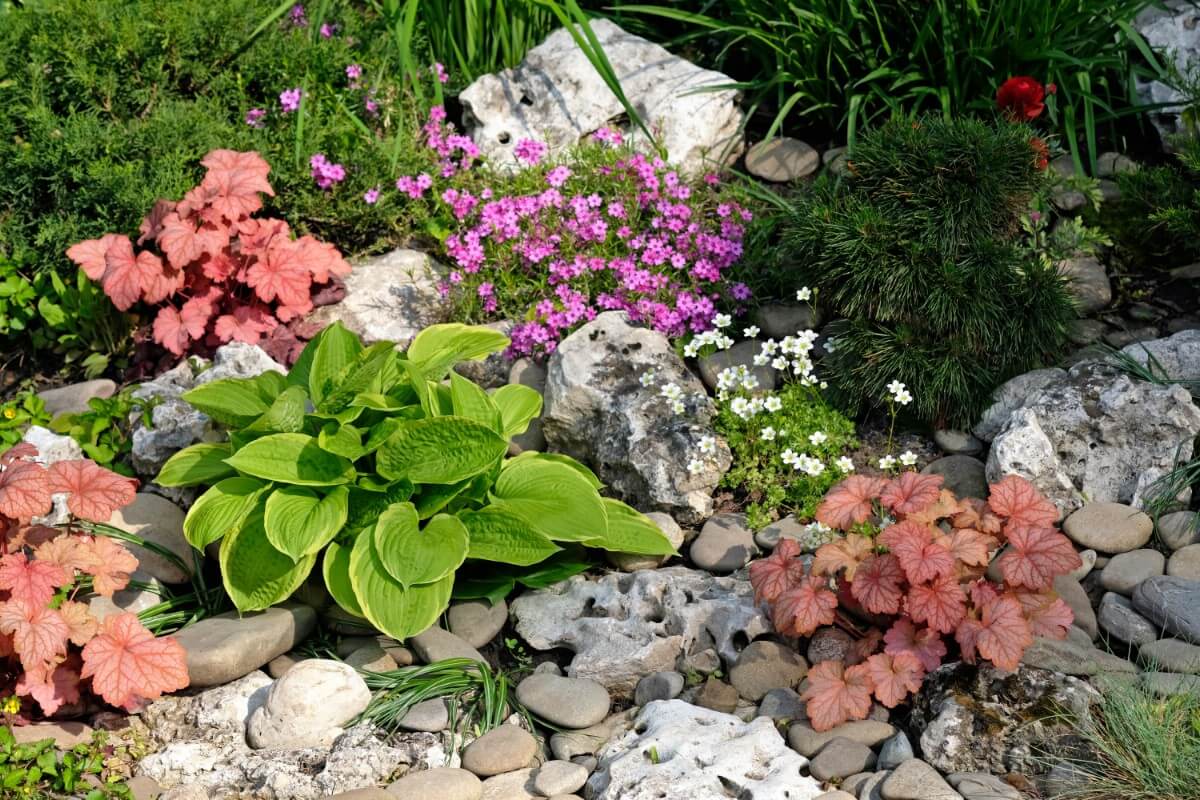
Hostas: Like coral bells, hostas are perennials that produce voluminous clumps of leaves. They also can be happy in a shady spot.
Ferns: Another popular combination for coral bells in a shady location are various types of ferns.
Astilbes: These dramatic plants feature plumes of bright, colorful flowers, and are a lovely accompaniment to coral bells.
Those are just a few possible ideas for companion plants to go with coral bells. There are numerous other options to explore, however, so feel free to get creative!
Frequently Asked Questions About Growing Coral Bells
Q: Are coral bells evergreen plants?
A: Coral bells may be labeled as evergreen or semi-evergreen plants.
Not sure what a semi-evergreen plant is? Horticulture explains, “Plants may be labeled as semi-evergreen for a variety of reasons. They are commonly called such when they fall between evergreen and deciduous in terms of growth. For example, they may shed their foliage for a very short time in late winter, rejuvenating rather quickly. Plants may also be referred to as semi-evergreen when they lose most, but not all, of their foliage for a fraction of the year. Sometimes they may be dubbed semi-evergreen due to specific situations that may arise. For example, during droughts, certain weather/climate conditions and/or due to certain insects.”
Both the cultivar you choose and your climate could have an impact on whether you end up with an evergreen or semi-evergreen plant.
Q: What eats coral bells?
A: If something is eating your coral bells, it is most likely that the culprit is an infestation of insects. But in some cases, there could be a mammal such as a deer eating them.
Q: Are coral bells deer-resistant?
A: Hypothetically, yes, coral bells are deer-resistant. Nonetheless, there are plenty of reports of deer making a meal out of them anyway. So, that is just something to be aware of if you are in an area where deer are prevalent.
Q: What is best to plant with coral bells?
A: Some ideas for companion plants for heucheras include spiderwort, bleeding hearts, and hostas, among others.
Q: Are coral bells annual or perennial?
A: Coral bells are perennial plants, meaning that their flowers come back year after year.
Where to Buy Coral Bells

Coral bells are amazing plants, featuring leaves that are every bit as dazzling as their flowers.
Are you ready to bring their colorful foliage to your garden? Click below to shop coral bells online.

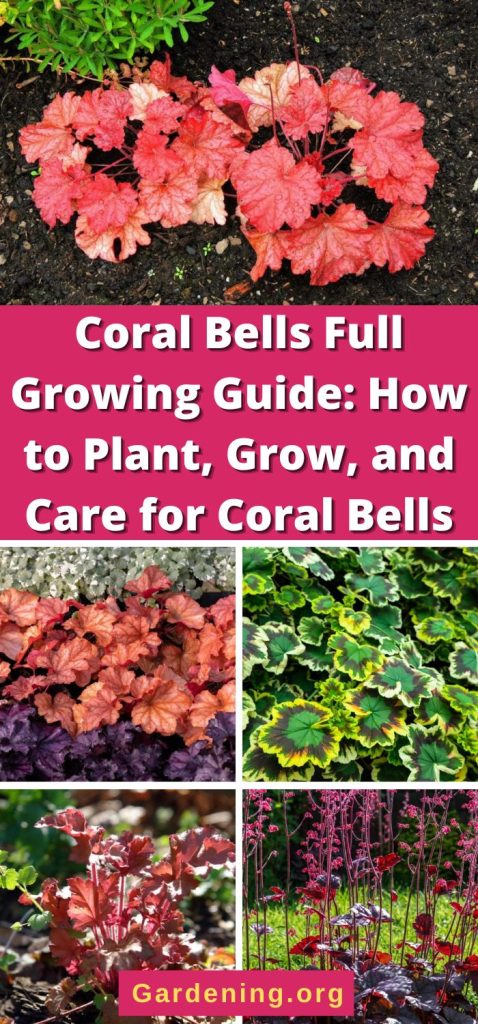
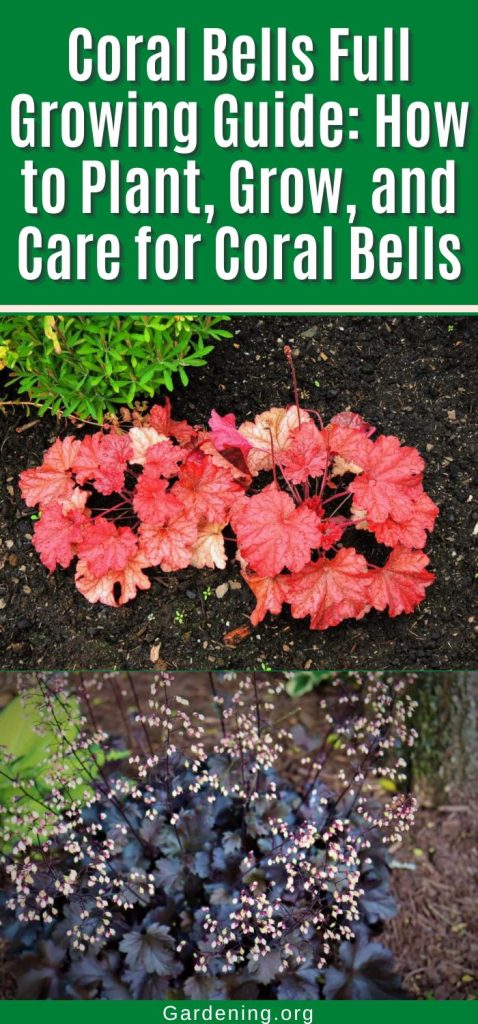
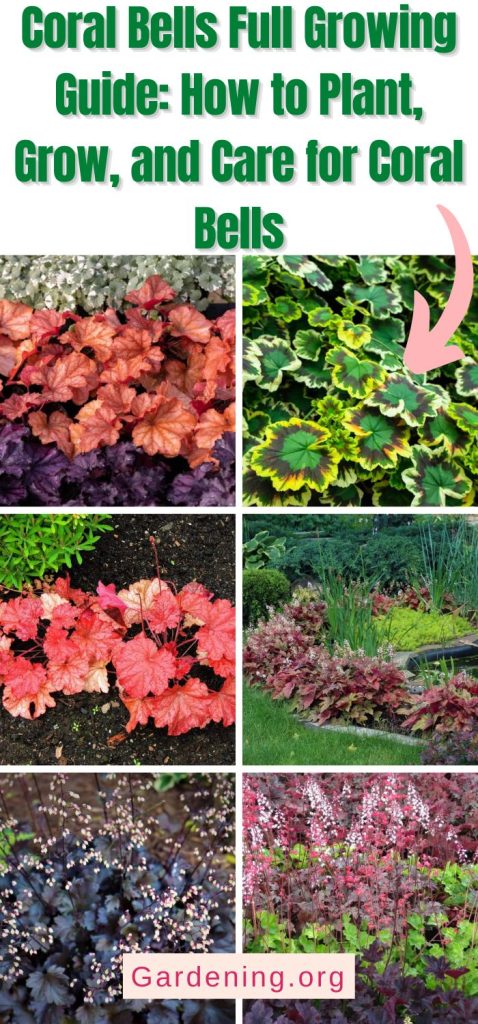
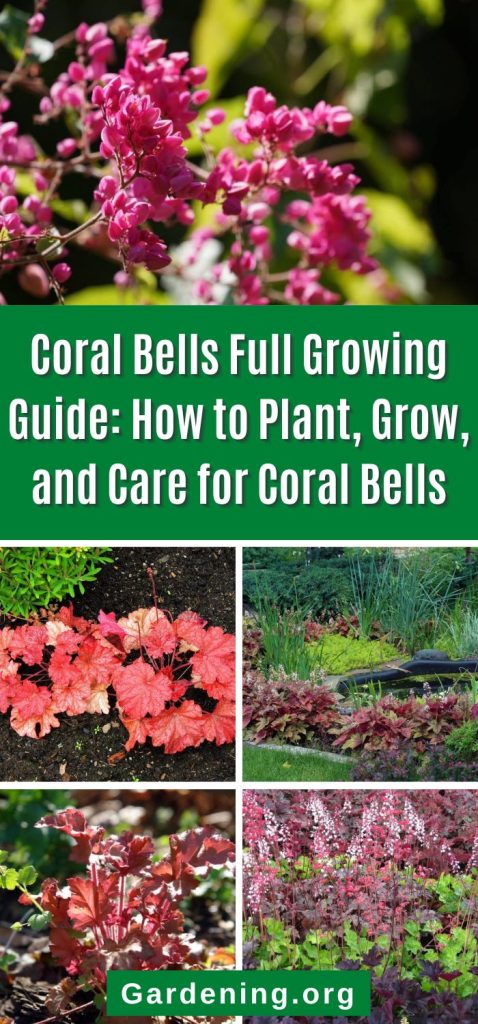

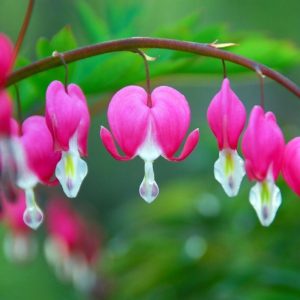

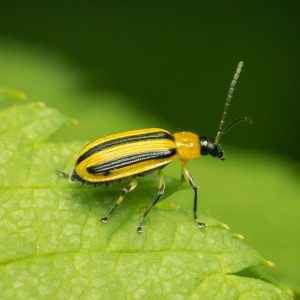
Leave a Reply